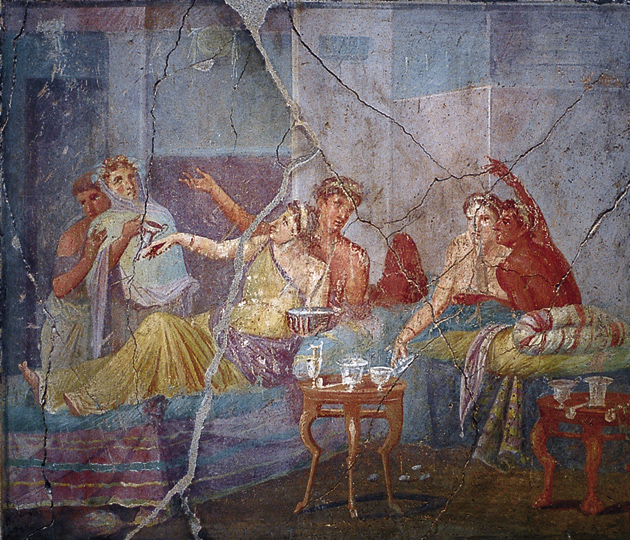The Mediterranean Sea is an area subject both to earthquakes and to volcanic eruptions. Usually of no great significance, they are occasionally shattering. In the year 79 AD, Vesuvius erupted to terrific effect, and with a force reckoned as equal to that of many atomic bombs. There had been warning tremors, and the more prudent inhabitants had fled from the populous towns and the luxurious villas that thronged the area, on the delightful and ever popular Bay of Naples.
Some people, of course, had stubbornly stayed in their homes and hoped for the best. We can imagine them saying, “Oh, come on: it won’t be any worse than all those other times, when people got alarmed and ran for the hills, and then, after all the fuss, nothing much came of it: they trooped back home again, looking pretty silly. And what about looters? If we all clear out, the thieves will simply help themselves.” The dead bodies of some of those people—too old, or too lazy, or too sanguine to flee—survive in considerable numbers. Encrusted in volcanic dust and mud, which set hard and gave them an unwanted immortality, they are specimens in the National Archaeological Museum of Naples, one of the great museums of the world.
The towns of Pompeii and Herculaneum, which were buried beneath the lava, preserve a picture of the ancient city that is unique, including its houses, possessions, and works of art, a picture that is ably presented by Mary Beard in her book The Fires of Vesuvius. It must be said at once that they do not give us everything that we might, ideally, have wanted. These were provincial towns. We are not dealing with Athens or Rome, or even with the great neighboring city of Neapolis—revealingly, a Greek name, meaning Newtown: whence modern Napoli, which in English we call Naples.
The town of Pompeii existed already in the archaic period. Traces survive from the seventh, eighth, ninth centuries BC. People have always wanted to live on the delicious Bay of Naples. Greek settlers, Etruscans, Oscans, Campanians, all occupied attractive sites and left evidence of their settlements. When Rome conquered and unified Italy, wealthy Romans flocked there; we find straitlaced or pessimistic commentators complaining that slackers, even among members of the Senate, preferred the luxurious half-Hellenized lifestyle of that seductive area—“more or less the ancient equivalent of St Tropez,” as Beard calls it—rather than the generally hard-faced and censorious atmosphere, and the dignified but less comfortable dress, of Rome, the conqueror of the world. Such complaints were generally ineffectual, and many upper-class Romans continued to prefer the softer and more interesting existence.
For those with a taste for such things, there were plenty of more cultured pleasures, too. There were Greek artists, Greek poets, and Greek philosophers—as well, of course, as the voluptuous luxuries of Hellenistic Greece, so much more sophisticated, and so much more exciting, than anything that was on offer in the comparatively modest city of Rome. It is in this Hellenized area of southern Italy, as Beard writes, that Petronius sets the grotesque character Trimalchio in his Satyrica, with his expensive jumble of half-understood Greek luxuries, pretensions, perversities, and absurdities.
Mary Beard has an interesting discussion of Pompeian dining. Trimalchio, with his fantastic and grotesque luxury, was by no means a typical Pompeian diner. The staple, for most people, was bread—no potatoes yet, of course, in the Old World. Graffiti scratched on walls, some of them with prices, suggest that bread, pork, sausages, cheese, small fish, olive oil, fruit, and (of course) wine formed the staples of most people’s diet. Beer was drunk only by barbarians. Wine was generally taken diluted, a practice still widespread in the Mediterranean world, and drinking your wine neat (merum) marked you as a boozer. We see Roman diners reclining on couches; only children ate sitting up. Those poorer citizens who couldn’t afford couches, Beard writes, “might occasionally take a special meal in a place such as the dining room in the Chaste Lovers bakery, where you could pay to eat in that style (even if it was located unglamorously between the pack animals and the flour mills).” Respectable Roman women dined with the men, a practice by which Greeks professed to be shocked.
Pompeii is not a Greek name, and the town was not founded by Greeks. What we see are the remains of the place as it was in the first century AD, when Pompeii was some five hundred years old. Among the remains are elements that are Greek, Etruscan, and Samnite—local Italian. We find traces of Jewish dietary rules beside bits of Indian bric-a-brac; there is evidence for the worship of the Egyptian gods, whose cult was fashionable in Italy at the time. This was a cosmopolitan place. Classical Rome did not try to impose any orthodoxy in religious matters until the ascendancy of the Christian faith brought with it the proscription of all pagan cults.
Advertisement
There is plenty of evidence at Pompeii for the cult of a wide range of deities, male and female, Italian and imported. There is even a statuette of the Indian goddess Lakshmi: an object of cult or just an imported curio? Beard mentions a graffito scratched on a wall of the theater that reads: “Methe, slave of Cominia, from Atella, loves Chrestus. May Venus of Pompeii be kind to them and may they live together happily ever after.” Methe means “intoxication”; the woman was surely a performer in some routine in which she boasted of her effect on her patrons or her spectators. Chrestus means “good” and was a common slave name, expressing the loyalty that masters and mistresses hoped to find in their staff. We also find some of the leg irons in which slaves might be tethered at night. There are a few remains of human bones fused to their chains by the heat of the eruption: not a nice death. Presumably the family simply panicked and fled, not stopping to release the fettered slaves.
Ancient houses tended to be, from our point of view, turned in on themselves. Rooms opened onto a central open space, the atrium. Windows to the outside world were few, and houses generally rather dark. Not all of them. Beard has an interesting discussion of the tall houses on the western edge of Pompeii, which had windows facing the sea. Nevertheless, these seem to have been a luxurious exception to a general rule. The darkness perhaps explains the fondness for very bright colors in interior decoration, including the famous “Pompeian red,” though, as Beard reminds us, some of this may be the result of volcanic heat.
For us the wall paintings of Pompeii have a special importance, as we have virtually nothing of the easel paintings, the works of art that were taken seriously in antiquity. We find here what we find so very rarely: some surviving examples of ancient painting. These towns are a principal source for our study of ancient art, but we must not forget that we are reconstructing and judging that art on the strength of the reproductions that were to be found in a couple of provincial towns. None of the famous masterpieces of ancient painting actually survive, although we do find copies of some of them. They are hand-painted, of course—it was a world without photographs. The statues, too, which we possess in considerable numbers, are mostly ancient reproductions of famous and popular pieces. Wealthy people liked to dot them about their gardens—a taste revived during the Renaissance and widely practiced by English milords in the eighteenth century.
What remains to be seen at Pompeii and Herculaneum, we are reminded by Beard, is the sort of taste that is typical of a rather middle-class town:
In all likelihood the Pompeian painters were working from a range of well-known and “quotable” masterpieces…. There is no reason at all to suppose that they had ever seen the original paintings.
Some paintings depict scenes from real life, hunting and fishing and the like, sometimes performed by dwarfs or grotesques; others aim to represent well-known mythological scenes, including Narcissus gazing at his own reflection and Medea steeling herself to kill her own children. Some depict more or less fantastic architectural constructions; some are meant to be Egyptian, with sphinxes and crocodiles. “And all this variety,” writes Beard,
was before you looked down at the floor, where, in the wealthier houses at least, almost anything that might be painted on the wall could also be turned into an image in mosaic, from guard dogs to the occasional full-scale battle. The “home decorating” of Pompeii springs all kinds of surprises.
Mary Beard deals with much else in The Fires of Vesuvius: gambling and trade, sex and politics, but, as she says:
While details like this are wonderfully evocative, the bigger picture and many of the more basic questions about the town remain very murky indeed…. The fact is we know both a lot more and lot less about Pompeii than we think.
This Issue
March 11, 2010




